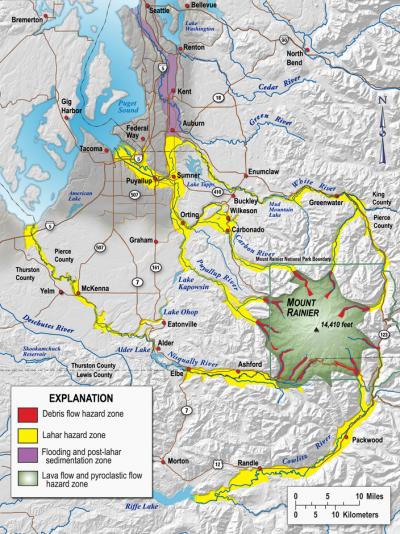The Pacific Northwest is one big conglomeration of
geographic landforms and formations. There is not one distinct form of
land form construction. One of the major and prominent forms of topography
is the visible evidence of volcanic and geothermal activity. Scattered along the Cascade mountain range is
a series of dormant volcanoes; some of which are not so dormant.
 |
| View of Pacific Northwest |
Cascadia: The series of volcanos along the Cascade range though Oregon
and Washington are referred to as Cascadia. The volcanic activity in Cascadia
is a product of subduction, where the Juan de Fuca and the North American
Plates are meeting. The Juan de Fuca place
is sinking below the North American plate just off the coast of Washington and
Oregon. This creates seismic activity
and in turn causes magma to travel to the surface. Though the likelihood of an eruption occurring
in the Cascadia is unlikely, but when an eruption does happen, it is often
violent. There is a lot of seismic
activity still accruing in the Pacific Northwest and is in need of monitoring
every day.
 |
| Juan de Fuca Subduction Zone Cross Section |
Mount St. Helens: Many of the dormant Volcanos are well known by most. The most famous is Mount St. Helens. At 8:32 Sunday morning, May the 18th,
1980, Mt. St. Helens erupted and amazed the world with its devastation and
beauty.
 |
| Mount St. Helens Eruption |
Mount Rainier: But is this the end of volcanic
activity in the Pacific Northwest? That
is a matter of opinion. Mount Rainier is
currently being watched by the PNSN because of its constant seismic
activity. On a daily basis there is
something occurring seismically from glacier movement to magma flows under the
volcanos surface. Rainier is the tallest
mountain in the Cascade Range at 14,410ft above sea level. But Rainier was once even taller than it is
now. There is evidence that like St.
Helens, the edifice of Rainier collapsed during an eruption leaving behind a
crater; that has over time rebuilt itself due to many eruptions.
 | ||
| Mount Rainier from Seattle |
Hazards Awaits: Mount Rainier is considered to be the most threatening
volcano in the Cascade mountain range. When
(not if) the next eruption occurs, the entire Seattle-Tacoma area is in high
risk of Lahar and flooding post Lahar. There
is not much we can do to prevent an eruption.
The best that can be done at the moment is continued surveys and studies
to remain aware of what is continuing to happen beneath the mountain
surface.
 |
| Areas of Impact from Rainier Eruption |
Works Cited
Pacific Northwest Seismic Network. 2013. http://www.pnsn.org (accessed February 16,
2013).
United States Geological Service. 12 17, 2012.
http://volcanoes.usgs.gov/volcanoes/mount_rainier (accessed February 16,
2013).
Wikipedia.
February 12, 2013. http://en.wikipedia.org/wiki/Cascadia_subduction_zone
(accessed February 16, 2013).